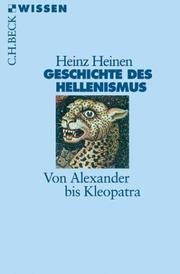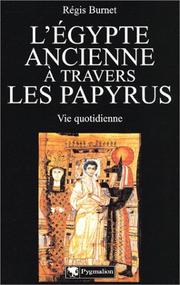| Listing 1 - 10 of 24 | << page >> |
Sort by
|

ISBN: 3406480098 9783406480096 Year: 2003 Volume: 2309 Publisher: München: Beck,
Abstract | Keywords | Export | Availability | Bookmark
 Loading...
Loading...Choose an application
- Reference Manager
- EndNote
- RefWorks (Direct export to RefWorks)
Hellenism --- Hellénisme --- Greece --- Grèce --- History --- Histoire --- Seleucids --- Egypt --- Syria --- Hellénisme --- Grèce --- Greece - History - Macedonian Hegemony, 323-281 B.C. --- Egypt - History - Greco-Roman period, 332 B.C.-640 A.D. --- Syria - History - 333 B.C.-634 A.D.

ISBN: 2857048106 9782857048107 Year: 2003 Publisher: Paris: Pygmalion,
Abstract | Keywords | Export | Availability | Bookmark
 Loading...
Loading...Choose an application
- Reference Manager
- EndNote
- RefWorks (Direct export to RefWorks)
Comment parlaient les hommes de l'Antiquité ? Que se racontaient-ils chaque jour ? Les écrits ont généralement disparu et l'on ignore bien souvent tout de leur intimité. Il existe cependant une exception : les papyrus de l'Egypte, miraculeusement sauvegardés grâce à l'aridité du désert. Il s'agit des plus anciens témoignages authentiques qui nous sont parvenus. Découverts il y a plus d'un siècle, les voici réunis pour la première fois dans une anthologie en français. Comment n'être pas fasciné : c'est un héritage direct du temps des pharaons qu'ils nous transmettent ! Entièrement traduits et présentés par Régis Burnet, ces extraordinaires papyrus révèlent une vie surprenante. Loin du ton parfois pompeux des œuvres littéraires, ils nous montrent des hommes de chair et de sang dans leurs préoccupations concrètes et les mille et uns secrets de leur existence quotidienne. Ainsi, mieux qu'à travers tous les récits et les reconstitutions, souvent sujets à caution, le naturel de leurs voix étrangement proches et vibrantes, comme si elles s'adressaient à nous, témoigne en direct et sans emphase de l'intemporalité de l'esprit humain.
Manuscripts (Papyri) --- Papyrus (Manuscrits) --- Egypt --- Civilization --- History --- Cultura y civilización --- Historia --- Papiros egipcios. --- Ancient Egypt --- Papyri. --- Egypt - Civilization - 332 B.C.-638 A.D. - Sources --- Egypt - History - Greco-Roman period, 332 B.C.-640 A.D. - Sources
Book
ISBN: 3519075385 9783519075387 Year: 1999 Volume: 5 Publisher: Stuttgart: Teubner,
Abstract | Keywords | Export | Availability | Bookmark
 Loading...
Loading...Choose an application
- Reference Manager
- EndNote
- RefWorks (Direct export to RefWorks)
Egyptian language --- Inscriptions, Egyptian --- Manuscripts (Papyri) --- Aswan Dam Region (Egypt) --- Egypt --- Historical geography --- Sources --- History --- Egyptian language - Papyri --- Égypte gréco-romaine --- Aswan Dam Region (Egypt) - Historical geography - Sources --- Egypt - History - Greco-Roman period, 332 B.C.-640 A.D. - Sources
Book
ISBN: 9657698103 9789657698105 Year: 2017 Publisher: Jerusalem: Polis Institute Press,
Abstract | Keywords | Export | Availability | Bookmark
 Loading...
Loading...Choose an application
- Reference Manager
- EndNote
- RefWorks (Direct export to RefWorks)
Created and developed by the Ptolemaic kings, the Library of Alexandria was regarded as the world's main center of scholarship from the 3rd century BC until at least the reign of Cleopatra (48-30 BC). The dream to establish a gigantic library that could assemble all known texts of the Hellenistic period, the outstanding achievements of the scholars who worked inside its walls, and, finally, the mysteries surrounding its disappearance, have bestowed an almost mythic status on this monumental library. Where was the Royal Library exactly located? What kind of texts were kept in that library? To what extent did the Library of Alexandria become a meeting point for different languages and cultures? Should we distinguish between the Museum and the Library from an institutional point of view? Were the book collections housed in separate buildings? What caused the destruction of those collections and how much was lost? Why do some ancient authors remain silent about the Library's disappearance? Polis--The Jerusalem Institute of Languages and Humanities held an international conference to seek answers to these question. The 2015 conference on the Library of Alexandria gathered historians, archaeologists, and linguists, as well as specialists on the Septuagint and on Greek literature. This book presents the proceedings of the interdisciplinary conference.
Libraries --- Civilization, Classical --- History --- Alexandrian Library --- Alexandria (Egypt) --- Egypt --- Intellectual life --- Libraries - Egypt - Alexandria - History - To 400 - Congresses. --- Civilization, Classical - Congresses. --- Alexandria (Egypt) - Intellectual life - Congresses. --- Egypt - History - Greco-Roman period, 332 B.C.-640 A.D. - Congresses.
Book
ISBN: 9783170216570 3170216570 Year: 2017 Publisher: Stuttgart: Kohlhammer,
Abstract | Keywords | Export | Availability | Bookmark
 Loading...
Loading...Choose an application
- Reference Manager
- EndNote
- RefWorks (Direct export to RefWorks)
Nach dem Zerfall des Reiches Alexanders des Großen übernahmen in den Diadochenkämpfen die Ptolemäer ganz Ägypten, das sie als Pharaonen bis zur Eingliederung in das römische Weltreich regierten. Unter ihrer 300-jährigen Herrschaft etablierte sich Ägypten zum wichtigsten, einflussreichsten und wirtschaftlich prosperierendsten Diadochenreich - die letzte Herrscherin, Kleopatra, fasziniert bis heute. Das Buch nimmt den Leser mit auf eine Reise durch die Geschichte Ägyptens in der hellenistischen Zeit und vermittelt die Grundlagen der antiken multikulturellen Welt am Ufer des Nils. Entlang der Reihe der Pharaonen wird der Leser in die Politikgeschichte Ägyptens eingeführt, gewinnt aber auch Einblicke in die Alltags-, Sozial-, Wirtschafts- und Religionsgeschichte.
Book
ISBN: 9780199571451 0199571457 Year: 2012 Volume: *3 Publisher: Oxford: Oxford university press,
Abstract | Keywords | Export | Availability | Bookmark
 Loading...
Loading...Choose an application
- Reference Manager
- EndNote
- RefWorks (Direct export to RefWorks)
Roman Egypt is a critical area of interdisciplinary research, which has steadily expanded since the 1970s and continues to grow. Egypt played a pivotal role in the Roman empire, not only in terms of political, economic, and military strategies, but also as part of an intricate cultural discourse involving themes that resonate today - east and west, old world and new, acculturation and shifting identities, patterns of language use and religious belief, and the management of agriculture and trade. Roman Egypt was a literal and figurative crossroads shaped by the movement of people, goods, and ideas, and framed by permeable boundaries of self and space.
Romans --- Romains --- Egypt --- Egypte --- Civilization --- History --- Civilisation --- Histoire --- Romans - Egypt --- Egypt - Civilization - 332 B.C.-638 A.D. --- Egypt - History - Greco-Roman period, 332 B.C.-640 A.D. --- Égypte --- 332 av. J.-C.-640 (période gréco-romaine) --- 332 av. J.-C.-640
Book
ISBN: 9782709621557 270962155X Year: 2009 Publisher: Paris: Lattès,
Abstract | Keywords | Export | Availability | Bookmark
 Loading...
Loading...Choose an application
- Reference Manager
- EndNote
- RefWorks (Direct export to RefWorks)
Excavations (Archaeology) --- Egypt --- History --- Antiquities, Roman --- Excavations (Archaeology) - Egypt. --- Egypt - History - Greco-Roman period, 332 B.C.-640 A.D. --- Egypt - Antiquities, Roman --- Grecs --- Égyptiens --- Hellénisme --- Papyrus d'Oxyrhynchos --- Oxyrhynchos (ville ancienne) --- Égypte --- Moeurs et coutumes --- Sources --- 332 av. J.-C.-640 (période gréco-romaine)
Book
ISSN: 02593823 ISBN: 9782724706284 2724706285 Year: 2012 Volume: 157 Publisher: Le Caire: Institut français d'archéologie orientale,
Abstract | Keywords | Export | Availability | Bookmark
 Loading...
Loading...Choose an application
- Reference Manager
- EndNote
- RefWorks (Direct export to RefWorks)
Avec l’arrivée des pouvoirs macédonien puis romain, la société de la vallée du Nil et sa culture matérielle connaissent de profondes mutations, bien que les traditions pharaoniques perdurent et continuent même de s’enrichir. L’Égypte est alors l’un des leviers essentiels de l’hellénisation et de la romanisation en Méditerranée orientale et ses confins, notamment grâce au verrou alexandrin.Depuis une vingtaine d’années, l’archéologie de l’Égypte gréco-romaine connaît un net redéploiement, qui permet une réflexion élargie à l’échelle de la Méditerranée.Le colloque organisé par la Société française d’archéologie classique en mars 2008 a souhaité rendre hommage à ce développement récent et fécond. Centrant le propos sur les « formes » spécifiques de la présence grecque et romaine dans la vallée du Nil, il a voulu diffuser ces nouvelles perspectives auprès des spécialistes du monde gréco-romain.La trame de cette rencontre s’organise en trois sections : de nouveaux modes d’appropriation des territoires, en particulier ceux des fronts de mer et des marges ; le cadre spatial, des espaces de la vie à ceux de la mort ; les objets, au sens large, de la statuaire au mobilier. On suivra tout particulièrement la manière dont les « modèles » des mondes grec et romain ont été adoptés et adaptés, livrant souvent des formules spécifiques au terrain égyptien.
Romans --- Romains --- Egypt --- Greece --- Egypte --- Grèce --- Civilization --- Civilization. --- Civilisation --- Greeks --- History --- Social life and customs --- Romans - Egypt - Congresses --- Greeks - Egypt - Congresses --- Egypt - Civilization - 332 B.C.-638 A.D. - Congresses --- Egypt - History - Greco-Roman period, 332 B.C.-640 A.D. - Congresses --- Egypt - Social life and customs - Congresses
Periodical
ISSN: 00019046 Publisher: Milano : Vita e pensiero,
Abstract | Keywords | Export | Availability | Bookmark
 Loading...
Loading...Choose an application
- Reference Manager
- EndNote
- RefWorks (Direct export to RefWorks)
Egyptology --- Manuscripts (Papyri) --- Egyptologie --- Papyrus (Manuscrits) --- Periodicals --- Périodiques --- Egypt --- Egypte --- History --- Histoire --- Papyrologie. --- Egyptologie. --- Oudheid. --- Egyptology. --- 332 B.C.-640 A.D --- Egypt. --- 22 <05> --- 932 <01> --- 930.279 --- #TS:KOMA --- 932 --- Bijbel--Tijdschriften --- Geschiedenis van Egypte--tot 640--Bibliografieën. Catalogi --- Papyrologie --- History Ancient world Egypt --- 930.279 Papyrologie --- 932 <01> Geschiedenis van Egypte--tot 640--Bibliografieën. Catalogi --- Périodiques --- Arts and Humanities --- Social Sciences --- Literature --- Archeology --- Periodicals. --- Manuscripts (Papyri) - Periodicals --- Egyptology - Periodicals --- Egypt - History - Greco-Roman period, 332 B.C.-640 A.D.
Book
ISBN: 3805333765 3805323921 3805335121 9783805333764 9783805323925 9783805335126 380533396X 9783805333962 Year: 2005 Volume: Band II Publisher: Mainz: von Zabern,
Abstract | Keywords | Export | Availability | Bookmark
 Loading...
Loading...Choose an application
- Reference Manager
- EndNote
- RefWorks (Direct export to RefWorks)
Temples --- History. --- Design and construction. --- Egypt --- History --- Antiquities. --- Temples - Egypt - History. --- Temples - Egypt - Design and construction. --- Temples - Nubia - History. --- Temples - Nubia - Design and construction. --- Egypt - History - Greco-Roman period, 332 B.C.-640 A.D. --- Egypt - Antiquities. --- 21.70 religious architecture. --- 15.52 Roman Empire. --- Römerzeit. --- Tempels. --- Romeinse keizertijd. --- Tempel --- Kaiser --- Religion. --- Tempel. --- Religion égyptienne. --- Époque des conquêtes romaines (Rome ; 4e siècle av. J.-C.-395). --- Temples égyptiens. --- 332 B.C.-640 A.D. --- Geschichte. --- Égypte --- Egypt. --- Ägypten --- Römer --- Ägypten (altes) --- Ägypten (Altertum). --- Egypte antique. --- Histoire --- Antiquités. --- Antiquités égyptiennes --- Fouilles archéologiques --- Égypte --- 30 av. J.-C.-640 --- Nubie
| Listing 1 - 10 of 24 | << page >> |
Sort by
|

 Search
Search Feedback
Feedback About UniCat
About UniCat  Help
Help News
News